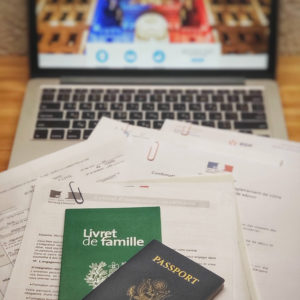What is the état des lieux d’entrée et de sortie? And why is it important?
Small disclaimer: I am not a legal expert nor a housing expert. The information contained in this post is from my personal research on this subject. If you need help being pointed in the right direction, I recommend starting with ANIL.
Understanding an État des Lieux
Before you get your keys, you need to do this : état des lieux d'entrée.
You’ve found your apartment and now it’s time to get the ball rolling. So what’s next ? There’s a whole list of things that need to be done in order to be comfortably moved in to your new place in Paris.
The état des lieux d’entrée (entry inventory analysis) is an inventory of the condition of the apartment that must be made when the keys are handed over to the new tenant(s). This report is attached to the rental contract and is used when the tenant(s) send notice of not renewing the lease. This document describes the state of the apartment and its equipment within when the tenant enters the premises. A new inventory will be fulfilled when the tenant(s) leaves the accommodation and returns the keys. In case of dispute, the comparison of these two documents allows to establish the responsibilities of each party.
In all my years of renting apartments in the Unites States, I have never had to do one of these reports before accepting the keys or leaving the apartment. Usually the landlord will go through at the end of your lease (or when you give notice) and if there are any issues, they will deduct them from your deposit, but there’s never been an official report.
How do you do an état des lieux d'entrée?
This is typically done on the day that the lease is signed and the keys are handed over to the new tenant(s). In our case, we did it a week early because the beginning of the month fell on a weekend holiday and the agency would be closing. The agent said it would only take 30 minutes of our time to walk through the unit together, but in reality, it took almost 2 hours. Thankfully I had requested the entire morning off work!
We started off by going through the keys. There were 4 sets of keys that came with the unit and they were not labeled. We ended up going through each set and figuring out which key went to which door/lock.
The form that is used during the inventory to mark the conditions of the unit can either be a physical or digital copy. Our agent had a tablet and was filling out a .PDF file as we went through the unit. The information indicated on the inventory form must be as accurate and precise as possible in describing the current state of the unit.
What goes on the entry inventory form?
- Type of inventory taking place.
- Date of inventory.
- Address of unit.
- Names of all those involved as well as the address of the landlord or the agency.
- If applicable, the contact information of the person(s) authorized to carry out the inventory. In the case of the landlord is not present and uses an agency.
- The last meter readings for the water and electricity (when charges are not included or paid with a fixed rate). This is usually done at the previous inventory.
- All keys and other means of access to private and common areas included with the unit.
- A detailed description of the unit, including but not limited to the condition of the floor, walls, ceilings, and and all equipments and other elements on the unit that are included in the lease. Pictures can also be included for further evidence to the inventory.
- The signature of all parties involved in the inventory.
Can I make changes to the inventory after it's done?
The tenant can ask the landlord or agent to modify the inventory up to 10 calendar days after the date the inventory took place. If the landlord or agent refuses to change the inventory report, the tenant can then apply to the department of conciliation commission where the unit is located.
The tenant can also ask about the condition of the heating elements within the first month of using the heating system. If the unit is equipped with a heating or hot water installation, the landlord can complete the inventory by comparing the previous meter readings with the current reading at the time of the new inventory.
How much does it cost?
Favorable Inventory
When the inventory is carried out by an agent, a part of the fee is paid for by the future tenant; this fee cannot be more than the part paid by the landlord and there is a cap of 3€ TTC per square meter maximum of livable surface*.
*Livable surfaces are calculated as the total floor area minus walls, partitions, steps & stairwells, door & window openings. Some exclusions to this include unfurnished attics, cellars, basements, sheds, garages, terraces, loggias, balconies, verandas, outbuildings, and space whose height is less than 1.8 m.
Unfavorable Inventory
If one of the parties (landlord/agent or tenant) refuse to show up for the inventory due to unexpected or personal reasons, a representative of the justice (aka bailiff) may be used. A bailiff will then notify both parties (landlord/agent and tenant) by registered letter a minimum of 7 working days before the set inventory date.
The fee of the bailiff varies depending on the size of the unit and this fee is split evenly between the tenant and the landlord. The following prices are set by the law:
Legal fee: 131,50€
Letter of invitation: 17,88€
Travel Cost: 9,20€
Legal fee: 153,20€
Letter of invitation: 17,88€
Travel Cost: 9,20€
Legal fee: 229,81€
Letter of invitation: 17,88€
Travel Cost: 9,20€
How do you do an état des lieux de sortie?
It is the same thing as the état des lieux d’entrée, a walkthrough of the premise to evaluate the condition of the place. The same information is used at the exit inventory that was used in the entry inventory and the same form is typically used in both procedures. This allows the landlord to assess if there has been any damage done to the unit and if there are any repercussions that need to be taken (aka deposit withheld or tenant charged for certain items/works).
What goes on the exit inventory form?
- Type of inventory taking place.
- Date of inventory.
- Address of unit.
- Names of all those involved as well as the address of the landlord or the agency.
- If applicable, the contact information of the person(s) authorized to carry out the inventory. In the case of the landlord is not present and uses an agency.
- The last meter readings for the water and electricity (when charges are not included or paid with a fixed rate). This is usually done at the previous inventory.
- All keys and other means of access to private and common areas included with the unit.
- A detailed description of the unit, including but not limited to the condition of the floor, walls, ceilings, and and all equipments and other elements on the unit that are included in the lease. Pictures can also be included for further evidence to the inventory.
- The signature of all parties involved in the inventory.
- Coordinates of the new location of the tenant.
- Eventually, any and all changed in the condition of the unit when compared to the entry inventory.
Unfurnished Unit
The exit inventory can be done on the last day of the lease or shortly thereafter, it is best to coordinate a date together for the exit inventory that best suits everyone. There is no cost to the tenant for the exit inventory as this is completely taken care of by the landlord. Unlike an entry inventory, the exit inventory cannot be modified once it is signed by all parties involved.
Furnished Unit
If the lease was signed on or before March 27, 2014, an exit inventory is not required. If there is mention in the lease of an exit inventory, the law does not require that it needs to be done. The documents can be used in the case that it is needed for legal reasons.
If the lease was signed after March 27, 2014, an exit inventory is required by law. There is no cost to the tenant for the exit interview and both the landlord and the tenant need to agree on a date for the inventory. If an exit inventory cannot be done in a favorable manner, then a bailiff will be called to intervene (see above information about using a bailiff).
So what's the point?
The état des lieux at both the beginning and end of the lease helps the tenant and the landlord figure out if there were any damages done during the term of the lease and who is responsible for them. This acts as a protection for both parties, but certainly the tenant.
That’s why when doing your état des lieux d’entrée it is important to note every possible thing, no matter how big or small you think it is. It’s also a good idea in the week after you’ve had the inventory and you’ve started to move in to also take a good walk around the unit and take the time to look over everything yourself. This is what the agent recommended us to do. He said it was easier if we took the time again after to look around because we wouldn’t be rushed and could take as much time as needed.


You May Also Like

Setting up your FranceConnect Account
17 January 2021
Understanding the Loi Madelin : A Guide for Self-Employed Professionals
26 November 2025